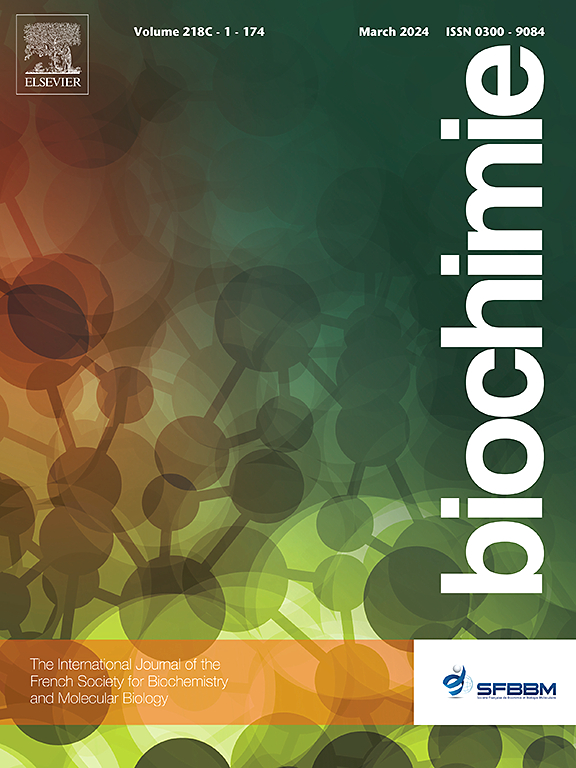硫原二氢苯并呋喃化合物作为潜在的神经保护剂:体外和硅生物学研究。
IF 3
3区 生物学
Q2 BIOCHEMISTRY & MOLECULAR BIOLOGY
引用次数: 0
摘要
氧化应激源于反应性物质(RS)的产生和抗氧化防御之间的不平衡,增加了大脑对神经退行性疾病和精神疾病的易感性。此外,单胺氧化酶(MAO)等神经递质代谢酶的表达或活性的变化也与包括抑郁症在内的精神障碍有关。考虑到这一点,通过体外和硅实验研究了6种2,3-硫基二氢苯并呋喃(2,3- dhbf)的抗氧化和MAO-A活性抑制潜力。化合物1至5将硫(S)作为硫,而化合物6则整合了碲(Te)。对脑MAO-A活性的筛选(化合物1-6)显示化合物2、4、5和6具有抑制活性。在含硫化合物中,化合物2在对接研究中表现出较高的分数,其值为- 9.9 kcal/mol。在浓度-响应曲线中,化合物2(含S)和6(含Te)在浓度等于或大于25 μM时抑制MAO-A。在氧化还原筛选试验中,只有化合物6具有抗氧化作用。浓度-响应曲线显示,化合物6降低小鼠脑组织(≥0.5 μM)脂质过氧化和蛋白质羰基化水平,降低≥1 μM RS水平。化合物6(≥5 μM)对铁离子(FRAP)有较好的还原作用。在2,2-二苯基-1-吡啶肼(DPPH)和2,2'-氮基-双(3-乙基苯并噻唑-6-磺酸)(ABTS)等自由基清除试验中,化合物6在50 μM浓度下表现出显著的清除效果,在100 μM浓度下模拟谷胱甘肽s -转移酶(GST)。总之,本研究证明2,3- dhbf具有大脑抗氧化和/或MAO-A抑制特性,具有潜在的神经保护候选物质。本文章由计算机程序翻译,如有差异,请以英文原文为准。

Chalcogen dihydrobenzofuran compounds as potential neuroprotective agents: An in vitro and in silico biological investigation
Oxidative stress arises from an imbalance between reactive species (RS) production and the antioxidant defense, increasing the brain susceptibility to neurodegenerative and psychiatric diseases. Besides, changes in the expression or activity of neurotransmitter metabolism enzymes, such as monoamine oxidases (MAO), are also associated with mental disorders, including depression. Considering this, antioxidant and MAO-A activity inhibitory potential of six 2,3-chalcogenodihydrobenzofurans (2,3-DHBF) was investigated through in vitro and in silico tests. Compounds 1 to 5 incorporate sulfur (S) as chalcogen, whereas compound 6 integrates tellurium (Te). A screening (compounds 1–6) of cerebral MAO-A activity showed inhibitory activity for the compounds 2, 4, 5, and 6. Among sulfur compounds, compound 2 demonstrated superior scores in docking studies, yielding a value of - 9.9 kcal/mol. Selected for concentration-response curves, compounds 2 (with S) and 6 (with Te) inhibited MAO-A at concentrations equal to or higher than 25 μM. In a redox screening test, only compound 6 showed antioxidant effects. Concentration-response curves indicated that compound 6 reduced lipid peroxidation and protein carbonylation levels in mouse brain tissue (≥0.5 μM), as well as reduced RS levels (≥1 μM). Furthermore, the compound 6 (≥5 μM) was effective in reducing the ferric ion (FRAP). In radical scavenging tests such as 2,2-diphenyl-1-picrylhydrazyl (DPPH) and 2,2′-azino-bis(3-ethylbenzthiazoline-6-sulfonic acid) (ABTS), compound 6 showed significant results in concentrations from 50 μM and mimicked the enzyme glutathione S-transferase (GST) at 100 μM. In summary, this study demonstrated the cerebral antioxidant and/or MAO-A inhibition properties of 2,3-DHBF, presenting potential as neuroprotective candidates.
求助全文
通过发布文献求助,成功后即可免费获取论文全文。
去求助
来源期刊

Biochimie
生物-生化与分子生物学
CiteScore
7.20
自引率
2.60%
发文量
219
审稿时长
40 days
期刊介绍:
Biochimie publishes original research articles, short communications, review articles, graphical reviews, mini-reviews, and hypotheses in the broad areas of biology, including biochemistry, enzymology, molecular and cell biology, metabolic regulation, genetics, immunology, microbiology, structural biology, genomics, proteomics, and molecular mechanisms of disease. Biochimie publishes exclusively in English.
Articles are subject to peer review, and must satisfy the requirements of originality, high scientific integrity and general interest to a broad range of readers. Submissions that are judged to be of sound scientific and technical quality but do not fully satisfy the requirements for publication in Biochimie may benefit from a transfer service to a more suitable journal within the same subject area.
 求助内容:
求助内容: 应助结果提醒方式:
应助结果提醒方式:


